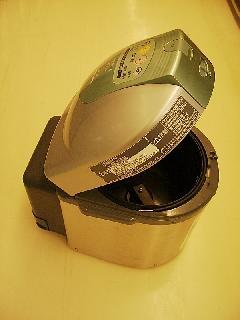Subsidies are available for the purchase of "household food waste processing containers".
Kitchen waste accounts for about 40% of Burnable Garbage.
The city provides partial subsidies for household food waste processing containers.
The types of processing containers include outdoor processing containers such as the non-electric kitchen waste composting container "Composter" that can be used as compost in home gardens, and indoor processing containers like "Kuutakun" that eliminate kitchen waste using the power of enzymes. There are also electric types, such as the drying processing container that reduces kitchen waste by using warm air from an electric heater and can automatically stir, and the bio-processing container that allows kitchen waste to be placed in fermentation material containing microorganisms, promoting fermentation and enabling automatic stirring.
Composting containers for kitchen waste are eligible for subsidies regardless of the model or retailer, including purchases made online.
Note: Please submit the "Application Form for Purchase of Home Composting Containers" to the Living Environment Division before making a purchase.
The purchase application form is distributed at the Living Environment Division and the Hirao and Wakabadai Branch Offices. It can also be downloaded from the PDF file at the bottom of the page.
After the application, we will send you the purchase approval letter and all necessary documents from the city. Please note that if you purchase the container before the approval letter arrives at your home, it will not be eligible for the subsidy.
Eligible Individuals for Grants
- Residing in Inagi City. However, this excludes business establishments, etc.
- The residue generated from the home composting container can be processed by the installer themselves.
- The purchased and installed composting container for kitchen waste can be maintained in good condition at all times, ensuring that it does not cause inconvenience to the surrounding area.
- The procedure for the grant must be completed within the same fiscal year.
Grant Amount
Regardless of the model or retailer, half of the purchase amount will be subsidized. However, there is a limit (the limit is as shown in the table below).
If there is a remainder of less than 100 yen in the grant amount, that remainder will be discarded.
|
Type |
Product Name (e.g.) |
Subsidy Amount (Maximum Amount) |
|---|---|---|
| Composting containers for kitchen waste and kitchen waste reduction containers, etc. Containers with a capacity of less than 190 liters |
Composter (under 190 type) and so on Kuutakun and others |
3,000 yen |
| Composting containers for kitchen waste and kitchen waste reduction containers, etc. Containers with a capacity of 190 liters or more |
Composters (Type 190 and above) and others |
6,000 yen |
| Electric Food Waste Disposal Container | (No specific product name) |
10,000 yen |
Note: Regarding the grant distribution, applications can be made for up to 2 units per household (1 unit per household for electric models). However, reapplication is possible if 3 years have passed since the last grant was received.
Please note that this system provides grants within the budget each fiscal year, so if the number of applications exceeds the planned amount, the grant will no longer be available. Therefore, those planning to make a purchase should confirm with the Living Environment Division.
How to Apply
(1) Application for Purchase
Please fill out the Application Form for the purchase of a home composting container (attached) and submit it to the Living Environment Division (fax submissions are not accepted). Mail submissions are also accepted.
After the review, we will send you the approval document for the purchase of the Inagi City composting container and all necessary documents.
(2) Purchase of Products
Once you receive the approval document for the purchase of the composting container for kitchen waste from the Living Environment Division, please purchase the composting container. (Any model or retailer is acceptable)
When making a purchase, please have the retailer fill out a sales certificate or obtain a receipt that clearly states the purchaser, retailer, manufacturer name, model of the processing machine, and the sales price.
(3) Grant Application
After purchasing the product, please submit the necessary documents within one month. After the procedure, the subsidy will be transferred to the designated account. Please understand that it may take some time (approximately one month) from the review to the transfer.


How to Use
| Type | Main Usage |
|---|---|
| Composting Container for Kitchen Waste | Bury the container about 10 centimeters underground to secure it, and when you add kitchen waste along with dry leaves and leaf mold, microorganisms will decompose it. Once the container is full, you can relocate it and use the fully decomposed kitchen waste as compost. |
| Compost Bin (Non-electric food waste processing container) |
Using a substrate combined with digestive enzymes and bamboo chips, by stirring well about 2 to 3 times a day, the organic waste is decomposed and disappears through the power of the enzymes. |
| Electric Food Waste Disposal Container | The typical types are the dry type and the bio type.
|
There are various other types available, so for detailed usage instructions, please contact the retailer or manufacturer.
Guidelines
To view the PDF file, you need "Adobe(R) Reader(R)". If you do not have it, please download it for free from Adobe website (new window).
Please let us know your feedback on how to make our website better.
Inquiries about this page
Inagi City, Department of Urban Environment and Development, Living Environment Division
2111 Higashi-Naganuma, Inagi City, Tokyo 206-8601
Phone number: 042-378-2111 Fax number: 042-377-4781
Contact the Living Environment Division, Urban Environment Management Department, Inagi City



















